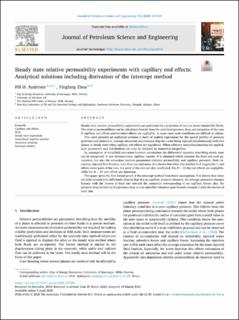Steady State Relative Permeability Experiments with Capillary End Effects: Analytical Solutions including Derivation of the Intercept Method
Peer reviewed, Journal article
Published version
Permanent lenke
https://hdl.handle.net/11250/2651466Utgivelsesdato
2020-04Metadata
Vis full innførselSamlinger
Originalversjon
Andersen, P.Ø., Zhou, Y. (2020) Steady State Relative Permeability Experiments with Capillary End Effects: Analytical Solutions including Derivation of the Intercept Method. Journal of Petroleum Science and Engineering, 192 10.1016/j.petrol.2020.107249Sammendrag
Steady state relative permeability experiments are performed by coinjection of two (or more) immiscible fluids. The relative permeabilities can be calculated directly from the stabilized pressure drop and saturation of the core if capillary end effects and transient effects are negligible. In most cases such conditions are difficult to obtain. This work presents an analytical solution in form of explicit expressions for the spatial profiles of pressure gradients and saturation, average saturation and pressure drop for a core being injected simultaneously with two phases at steady state when capillary end effects are significant. When arbitrary saturation functions are applied, such parameters and distributions can only by obtained by numerical integration. By assumption of simplified saturation function correlations the differential equation describing steady state can be integrated. A new dimensionless capillary number 𝑁𝑁 is obtained which contains the fluid and rock parameters, but also the saturation function parameters (relative permeability and capillary pressure), fluid viscosities, injected flow fraction, total flow rate and more. It is shown that when this number is of magnitude 1, end effects cover parts of the core, but parts of the core are also unaffected. For 𝑁𝑁>10 the end effects are negligible, while for 𝑁𝑁<10 end effects are dominant. This paper gives the first formal proof of the intercept method from basic assumptions. It is shown that when the inlet saturation is sufficiently close to that of a no capillary pressure situation; the average saturation changes linearly with the inverse of total rate towards the saturation corresponding to no capillary forces; also, the pressure drop divided by the pressure drop of a no end effect situation goes linearly towards 1 with the inverse of total rate.
